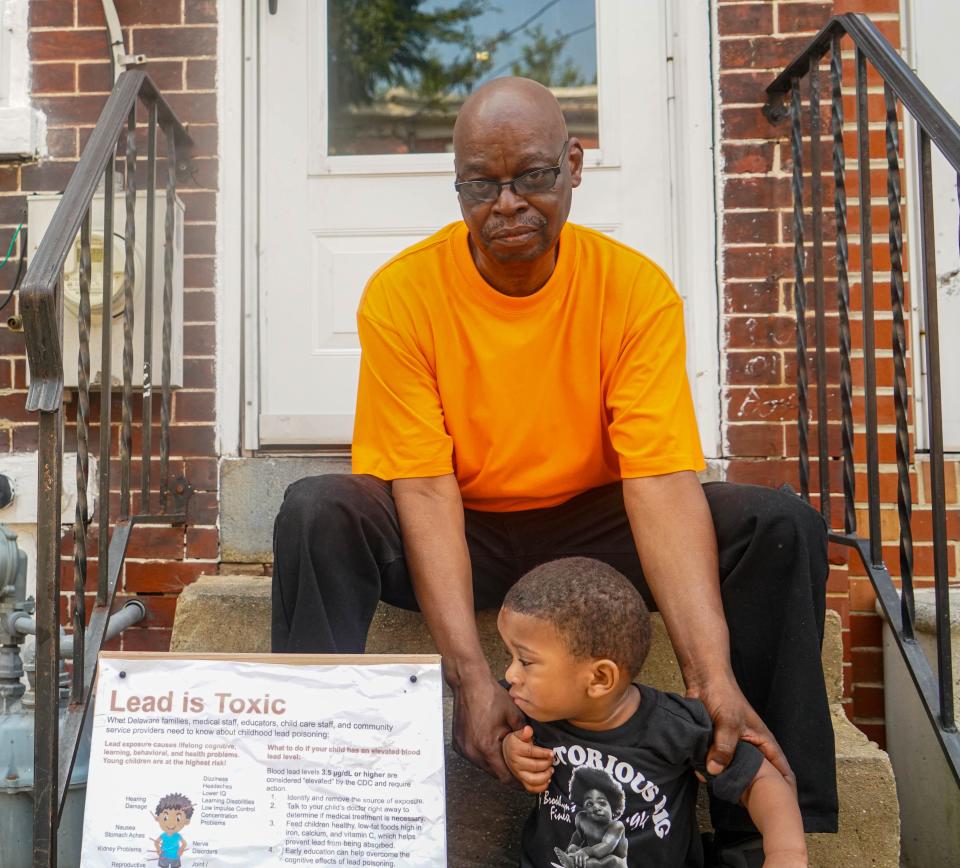This Wilmington child was lead poisoned. How it could have been prevented
EDITOR'S NOTE: This story has been updated to note that New Castle County's "No Lead" Program has an income restriction, as well as to include the state's funding opportunities to address lead in homes.
It was completely preventable.
James Gibbs’ partner was still pregnant when outreach workers for New Castle County’s “No Lead” program came to the lifelong Wilmington resident’s home on North Spruce Street in 2020 warning about the hazards of lead exposure.
Gibbs would later discover in a home lead-risk assessment by the Delaware Division of Public Health that the hazardous material was everywhere.
The baseboards? Lead-based paint.
Around the windows and doors? Also lead.
“There is lead throughout the house including the carpet,” Gibbs told Delaware Online/The News Journal during an interview at his home on Wilmington’s East Side.

The row home at 848 N. Spruce St. is one of many 100-plus-year-old houses that is almost guaranteed to have lead-based paint. The community is among the targeted ZIP codes for New Castle County's Lead Program, which offers property owners up to $20,000 in free lead remediation services, but only if tenants and property owners agree.
Gibbs’ landlord, Steven Eastburn, declined.
FIRST TIME FUNDING: Delaware wants to spend $3M on childhood lead poisoning prevention
At the time, Eastburn said Gibbs owed back rent and he had no indication that the home had any lead hazards. The property owner added he didn’t want to start a remediation project if Gibbs would have to be evicted because of the alleged back rent.
“If there had been some indication that there was a child that had an elevated level. … I just didn’t have any indication of that,” Eastburn told a Delaware Online/The News Journal reporter on July 10. “There’s never been any other indication that there’s any problem or issue in that house.”
To complicate matters further, the landlord said he was never contacted by the state nor received the lead risk assessment report until a reporter contacted him about the issue.
Jen Brestel, communications manager for the Delaware Department of Health and Social Services, said she was "not aware of whether the homeowner received a copy" of the assessment at the time public health officials forwarded the report to New Castle County.
The state was working with the county since the North Spruce Street property qualified for the lead removal program, Brestel said.
"For expediency purposes, DPH Office of Healthy Environments conducted the lead risk assessment in New Castle County’s place," she wrote in an email.
That explanation, however, doesn't match Gibbs' experience.
Gibbs recalls receiving a letter from the county on Oct. 18, 2021, about five months after his son was born, informing him the home was not eligible for the lead program because the "required documentation" hadn't been submitted.
COMMUNICATION BLUNDERS: Public was supposed to be notified about lead in schools, why weren't they?
By Oct. 26, 2022, the baby’s blood lead levels were double that of the Centers for Disease Control and Prevention’s 3.5 micrograms per deciliter (mg/dL) minimum for elevated blood lead levels in children, Gibbs' son's lab results show. Two months later, they rose to 9.3 mg/dL.
The father said the doctor assured him he'd be hearing from the state within weeks. When that wasn't the case, Gibbs said the doctor resubmitted the elevated blood levels to the state.

“I’m really bitter because of what happened to my son. It was preventable,” said Gibbs, whose now-2-year-old son appears to be showing signs of autism and hyperactivity. “All (the landlord) had to do was say OK.”
But Eastburn didn’t agree to participate in New Castle County’s program, which left 848 N. Spruce St. inhabitants exposed to lead − a hazardous material that can lead to developmental and behavioral issues; damaged brain and nervous systems; and hearing and speech delays in young children even at low exposure levels. Babies in utero are also at risk if the mother is exposed to lead while pregnant because it can pass through to the fetus.
The toddler’s elevated blood lead levels were discovered during one of several routine wellness exams infants receive during their first years of life. The results are then forwarded by the pediatrician to the state’s public health division, and if a child has blood lead levels of 7 mg/dL or above, the family receives case management.
The diagnosis has put Gibbs at odds with his landlord, made him fearful of what more his son and other children are being exposed to at the North Spruce Street home, and forced him to scramble to access additional services for his son − all while searching for a new place to live.
“It should be put into law that before (landlords) rent a house, they should show (Licenses and Inspections) that a house built before 1978 is lead-free,” Gibbs said. “Until then, they are going to keep getting away with this.”
How are lead hazards removed from homes?
After receiving the home risk assessment – which Eastburn said he didn’t obtain until July 7 after reaching out to the state health department – the property owner said he is moving forward with remediation through New Castle County’s "No Lead" program.
The free, voluntary remediation program is available to renters, landlords and property owners with homes in the targeted ZIP codes; homes built before 1978; homes where a child under the age of 6 and/or a pregnant woman lives; and for households that meet the federal income restrictions. To move forward with remediation, all parties − from the tenants to the property owner − must agree.
Franchon Dickinson, project director and program manager of the county’s lead program, said there is no state law that requires people to participate.
WATCHDOG REPORT: How Delaware's handling of lead water testing put thousands of students and staff at risk
“We work with the tenant and landlord to get documents signed and approved,” she said, adding they relocate tenants to temporary housing during the remediation at no cost to the landlord or renters. Remediation takes up to two weeks, and afterward, crews check to ensure there are no lead hazards before moving tenants back in.
“Typically," she said, "we don’t have problems with landlords because they’re usually excited to get this free work on their house.”
Eastburn said he had no qualms with the county program at the time, but he didn’t want to start a project given the tenant’s situation.
“If he ends up having to be out of the property in 60 days, I don’t want to enter into a partnership with the county and tenant,” he said.
Dickinson confirmed county officials spoke with Eastburn, who indicated he wasn’t going to participate because of “rent issues.”
“We typically have no problems with the landlord allowing us to do this work, but in this particular case, there is something outstanding that is outside our purview,” she said. “We cannot use our program to leverage anything for the tenant.”
There are currently no laws that force a property owner to remediate lead hazards in a home, but a bill passed this year aims to create a system to ensure prompt screening of homes for the hazardous material and allocates funding for remediation.
Senate Bill 9 tasks the state's Division of Public Health with identifying lead exposure sites any time a child returns a blood lead level of 3.5 micrograms per deciliter or above (unless the Centers for Disease Control and Prevention set a different maximum level) and notifying the property owner of those exposure points.
The bill also creates a public fund to help property owners remediate lead-based paint hazards in homes where children have elevated blood lead levels and outlines requirements for remediation and notification to impacted residents. It prohibits landlords from increasing rent for three years following lead remediation if public funds are used.
The bill was recently signed by Delaware Gov. John Carney and includes $2 million for lead abatement and $1 million for lead risk assessments in homes.
New Castle County’s program has received millions of dollars in federal funding.
In 2019, the county was awarded $3.3 million for its No Lead Program and $2 million for the Healthy Homes Production Grant Program from the U.S. Department of Housing and Urban Development.
Dickinson said this will allow the county to address lead and other home hazards in over 260 homes.
The Healthy Homes program also identifies and remediates home hazards like radon, carbon monoxide, lead, dampness and mold, leaking roofs, excess heat and/or cold, falls in the bathroom, electrical hazards, structural collapse, light issues, pests and food safety, or unsafe windows and doors. Funding from this program is available for all New Castle County ZIP codes.
What happens when a child is lead poisoned?
Years of lead-based paint dust has settled into the matted brown carpet at 848 N. Spruce St. where Gibbs has lived for nearly six years. If he doesn’t shampoo the carpet weekly, Gibbs said he can take a tissue to his nose and wipe away black dust from his nostrils.
The home lead risk assessment performed in February at the North Spruce Street rental − prompted after Gibbs’ son returned elevated blood lead levels − found high levels of lead in the home’s baseboards, door jams and casings, and window jams, interior casings and sills. Lead-paint dust also collected on the kitchen floor, but the highest levels were concentrated on window sills in the living room and front bedroom, the assessment found.
Gibbs’ shared the home risk assessment with Delaware Online/The News Journal. The Division of Public Health declined to provide the assessment due to “privacy concerns,” though the assessment includes no identifying health information and could be redacted.
The assessment for Gibbs' home advises lead remediation be performed by a certified lead abatement contractor because of the specific process and handling of lead-paint removal. Occupants should also routinely and thoroughly clean the home, wiping window sills and other child-accessible surfaces with "tri-sodium phosphate detergent or Spic-n-Span" to reduce exposure.

The 64-year-old Wilmington resident said he has asked his landlord for supplies to address the flaking and peeling paint, but the requests are ignored. In the dining room, a gaping hole in the ceiling remains a reminder of a bathroom leak from three years ago. And within the last year, another hole in the living room ceiling has formed from intruding rainwater.
“If I had somewhere else to go, I would have,” Gibbs said. “He’s just going to rent to someone else.”
About three months after his son returned elevated blood lead levels, the Division of Public Health reached out to Gibbs with information on how to reduce exposure to lead-based paint.
Kurt Olinger, administrator of the Office of Healthy Environments at the Division of Public Health, which includes the Childhood Lead Poisoning Prevention and Healthy Homes programs, said officials try to connect with families shortly after receiving notice of the elevated levels, but staffing issues, as well as gaps in the information submitted by doctors to the database, can make outreach challenging.
RELATED: Delaware claims, without data, that childhood lead exposure not caused by drinking water
For instance, on rare occasions information mailed to a family is returned because of inaccurate addresses, he said.
Any time a child returns levels above 3.5 mg/dL, information and resources are mailed to the family on how to remove or reduce lead sources in the home and what the risks of exposure are, Olinger said.
“It has contact information for our case managers. (Outreach) also includes making sure they are contacting their doctor for follow-up testing,” he said. “We also provide information for developmental intervention.”
Case managers reach out once a child’s blood lead level gets to 7 μg/dL or above, Olinger said.
On a weekly basis, public health officials review a database where medical professionals and labs input lead test results and identify children with elevated blood lead levels for case management.
Delaware typically has about 100 to 120 families receiving case management for a child with elevated blood lead levels, Olinger said.
“Most cases seem to resolve in under a year. We rarely have anything going on longer than a year,” he said. “We will follow through with them until they fall off and get below 7 μg/dL.”
What is required for blood lead testing?
The long-fought passage of House Bill 222 in 2021 requires all physicians and healthcare providers to screen children for lead exposure at 12 months and again at 24 months of age.
The bill was passed in hopes of simplifying the requirements and eliminating confusion to increase compliance for testing, which the legislation acknowledged was “low.”
The bill defines screening as a “capillary blood test” − most commonly a finger prick sample; clarifies insurance coverage; and directs the Division of Public Health to report on elevated blood lead levels to the General Assembly annually, according to the bill.
Prior to its passage, children were required to get tested only once by the age of 1. A second test was at the discretion of medical professionals and based on a child’s lead exposure risk.
Lead-Free Delaware advocate Amy Roe said testing at 2 years old is more effective at detecting lead poisoning “due to an increase in hand-to-mouth behaviors while children are more mobile in the home, and therefore the ingestion of lead dust is greater at 2 years of age than at 1 year of age.”
Delaware lawmakers since at least 2018 have tried to pass legislation requiring routine childhood lead testing, but some medical professionals oppose the measure and have continued to do so, causing the bill’s regulations to languish.
The regulations have been opened up for public comment four times since May 2022, with the latest solicitation for comment ending in June. They still haven’t been finalized.
Gibbs’ son was just over a year old when he was first tested for lead exposure, a screening that is required for every child enrolling in public schools and akin to the vaccinations needed when starting kindergarten.
The venous blood draw was difficult for the baby, Gibbs said. His son screamed during the draw, Gibbs said, adding that because his son was so small, it was hard to find a vein.

A finger prick, or capillary, test is used first to screen for lead levels, said Dr. Mary Beth Wroblewski, the pediatric residency program director at Johns Hopkins All Children's Hospital in St. Petersburg, Florida. If the levels are high, then a venous blood draw is done as a diagnostic test, she said.
"Most screening tests available cannot detect levels lower than 3 mg/dL and the screening test may return false positive results — higher levels than what is shown on the venous test," Wroblewski said. "This is the reason that any amount of detected lead found on a finger prick/capillary test needs to be confirmed with a blood draw."
The finger prick test is "tolerated well by most children," she said, and is simple to do in a doctor's office without having to get blood drawn from a vein.
When explaining the need for the test, the Florida doctor said medical professionals remind parents that "lead screening is a universal recommendation from the American Academy of Pediatrics at age 1 and 2 years, so it is part of the standard well-child visits at these ages."
Delaware medical professionals and state health officials have resisted the national academy's recommendations on childhood lead poisoning and prevention.
LEAD PREVENTION: Delaware spending $3.8M for water filters in schools statewide after elevated lead levels
Nemours Children's Hospital, which has worked closely with state officials on Delaware's lead poisoning prevention efforts, did not respond to requests for comment regarding what blood lead testing is like for children in the First State.
Children who enter kindergarten or go to a child care facility in Delaware are required to submit proof of lead screening, but school nurses − who are tasked with confirming the documentation in elementary schools − say less than half the students enrolled each year had the paperwork.
Delaware’s 2022 Childhood Blood Lead Surveillance report − an annual report required since the passage of House Bill 222 − indicates the state’s Division of Public Health received 8,627 blood lead test results for children ages 0-72 months but does not note how those numbers compare with the total number of children in Delaware.
The final language of the bill states about 23% of Delaware's children are screened for lead levels each year.
The U.S. Census Bureau estimates Delaware had about 53,975 children under the age of 5 in 2022. Using those figures to compare the total tests received in 2022, only 16% of the state’s children were checked for lead poisoning last year.
The Johns Hopkins doctor said the most common reason a child may not be screened for lead is because normal wellness appointments are missed. Other barriers to testing include a doctor's office not having the finger stick test available or there isn't a lab to do the venous test, Wroblewski said.
Got a tip? Contact Amanda Fries at afries@delawareonline.com, or by calling or texting 302-598-5507. Follow her on Twitter at @mandy_fries.
This article originally appeared on Delaware News Journal: Why lead poisoning of this Wilmington child could have been prevented

